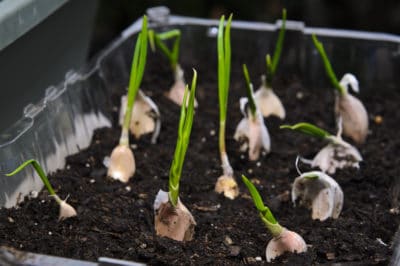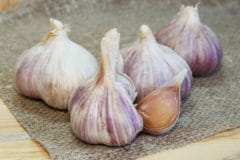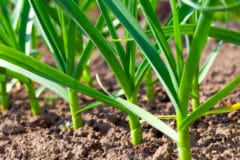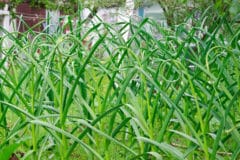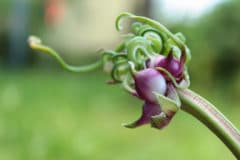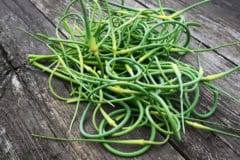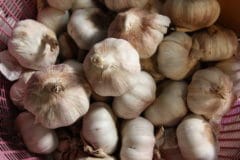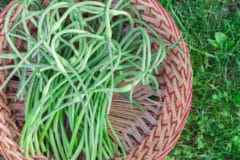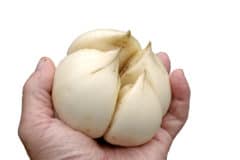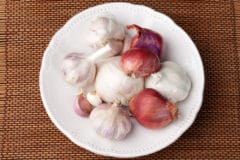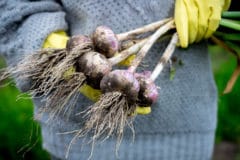What’s the Best Way to Grow Garlic Indoors?
What’s best depends on your circumstances. You’ll probably have the best results by growing in a greenhouse or under lights inside. In most cases, a sunny windowsill won’t provide enough light for this long season plant. Once a windowsill has enough light for good growth, it’s often too hot for garlic, which is really a cool season plant.
What Containers Should I Use?
Although garlic is a relatively shallow-rooted plant, it still needs plenty of room for the roots to spread. Your containers should be about 18 inches deep. The minimum width for a single plant is four inches, and 12 inches is the minimum for multiple plants. Drainage is critical; garlic can suffer from rot and fungal diseases if the soil is constantly wet.
How Do I Grow Garlic on a Windowsill?
If you want to grow garlic on a windowsill, be careful about the direction the window faces. North exposures don’t have enough light, while south exposures are likely to be too hot as the weather warms. East and west exposures are best. Your garlic needs at least six hours of direct sunlight each day. Rotate the pots one quarter turn daily so growth is even.
How Do I Grow Garlic in a Greenhouse?
Garlic grows well in a greenhouse as long as the humidity doesn’t get too high. A greenhouse provides plenty of light and – except in the heat of summer – offers the cool season conditions garlic prefers. A greenhouse is particularly effective in areas with winter snow. Grow as you would outdoors, in fertile, well-drained loose soil. You can grow in beds or containers. The greenhouse need not be heated.
How Do I Grow Garlic in the Basement?
Garlic can be grown in a basement or other indoor room if you use grow lights. Use a commercial planting system or make your own with tables/shelves and hanging lights. A timer may be useful to ensure the plants get adequate light and darkness. The lights should mimic full-spectrum sun and should be as close to the plants as possible.
How Should I Prepare the Soil?
Garlic is a heavy feeder. Use a good commercial potting soil and add a balanced 10-10-10 organic fertilizer. You can also mix regular garden soil that has added aged manure, well-rotted leaf mold and sand to create sandy loam for your containers. The soil and potting soil can also be mixed half and half. Water with seaweed or fish emulsion to add extra nutrients during the growing period.
How Do I Water Garlic?
Garlic prefers moist soil but can’t handle being water-logged. Water whenever the top inch of soil seems dry. Aim for a minimum of one inch of water a week. Deep watering is better than sprinkling the plants. Make sure your containers or beds drain well. Pay attention to humidity – if it’s too high, it can encourage disease. Encourage air circulation by opening windows or using a fan.
What Are the Best Varieties?
Garlic varieties are either hardneck or softneck. Hardnecks send up a flower stalk with edible buds (scapes); softnecks don’t. However, softnecks have more cloves and store better. There are hundreds of varieties available. Here are some readily available types:
- Chesnok Red – hardneck
- Inchelium Red – softneck
- Italian Late – softneck
- Music – hardneck
- Purple Italian – hardneck
- Silver Rose – softneck
- Spanish Red – hardneck
When Do I Harvest Garlic?
Garlic is a long-season plant. If you plant it in fall, it must undergo a semi-dormant period when the roots are developing but nothing is growing above ground (much like a daffodil). This period adds about two months to the expected maturity date. Maturity dates for garlic range from around 90 to 120 days. Fall-planted garlic will typically take about 240 days.
What Do I Do with Scapes?
Scapes are the immature flower buds of a garlic plant. They only grow on hardneck garlic. Scapes can be harvested and used just as you would garlic cloves. They can also be dried and frozen or turned in pesto. You should cut off the scapes even if you don’t want to eat them, as it forces the plant to concentrate on clove development.
